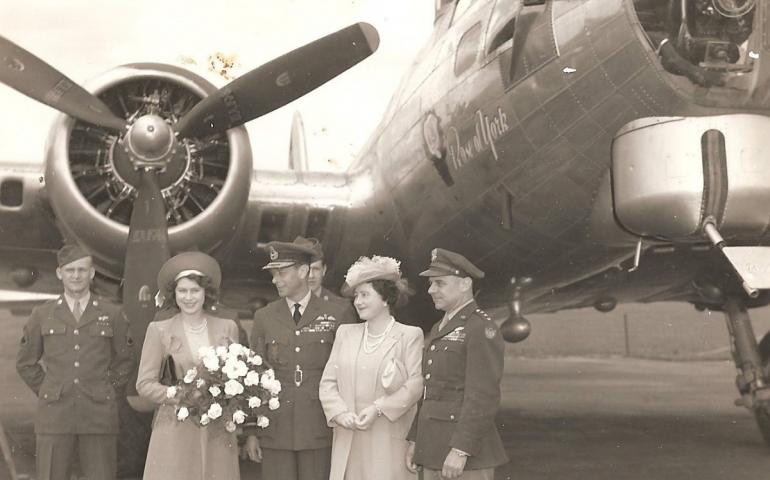
Rose of York, July 6, 1944
B-17G Flying Fortress, B-17G-55-BO, Serial No. 42-102547, Marking: GY F
Nik Name: Rose of York, from the 8th Air Force 306th Bomb Group (Heavy), 367th Squadron.
In honor of Her Royal Highness Princess Elizabeth, a United States Army Air Forces heavy bomber, Boeing B-17G-55-BO Flying Fortress 42-102547, was christened Rose of York. The ceremony took place at R.A.F. Thurleigh (U.S.A.A.F. Station 111), 5 miles (8 kilometers) north of Bedford, Bedfordshire, England. Named for Princess Elizabeth Windsor (now Her Majesty Queen Elizabeth II), 42-102547 was originally named Princess Elizabeth, but this did not meet with official approval. (There were concerns about propaganda value to the enemy and the effect on civilian morale should the bomber, named after a member of the royal family, be lost in combat). The aircraft was instead renamed Rose of York and christened by the Princess during her royal visit to the airfield. After the ceremony, the bomber was flown to RAF Molesworth, where a number of photographs were taken.
The B-17G, Serial No. 42-102547 was built in early 1944 by the Boeing Airplane Company at its Plant 2 south of Seattle, Washington. The new bomber was not camouflaged, but left in its natural metal finish. On March 12, 1944, it was flown to the Cheyenne Modification Center at Cheyenne, Wyoming, where the latest combat modifications were installed. It was then taken to the B-17 training base at Grand Island Army Air Field in central Nebraska. From there she flew to Dow Army Air Field in Bangor, Maine, where she arrived on April 3, 1944, and was then transferred to England via the North Atlantic. The Flying Fortress arrived in England and was assigned to the 401st Bomb Group, Heavy, at R.A.F. Deenethorpe (A.A.F. Station 128) on May 2, 1944. Three days later, however, B-17G, Serial No. 42-102547 was transferred to the 306th Bombardment Group, Heavy, at R.A.F. Thurleigh. She was assigned to Captain Perry E. Raster of the 367th Squadron. The group's identification, "Triangle H" - a white capital "H" in the center of a black triangle - was painted on the vertical stabilizer above the serial number. Below that, a black capital "F" was painted, identifying the individual aircraft within the squadron.
The B-17G, Rose of York, Serial No. 42-102547 had completed 13 missions by July 6, 1944.
The crew of the Rose of York on July 6, 1944.
Pilot : Lt. Vernon Daley
Co-Pilot: 2nd Lt. Joseph Carbine
Navigator: 1st Lt. Paul Becker
Bombardier: S/Sgt. Robert Crede
Engineer /Top Turret Gunner: T/Sgt. Reisel Horn
Radio /Top Gunner, T/Sgt. Porfirio Marquez
Ball Turret Gunner: S/Sgt. George Petrillo
Waist Gunner: S/Sgt. Silvio DeZolt
Tail Gunner: Sgt. Okey Coplin
British Broadcasting Company (BBC) war correspondent Guy Byam (civilian)
B-17G, Serial No. 42-102547 with the name Princess Elizabeth
On Saturday, February 3, 1945, the 8th Air Force, under the command of Lieutenant General James Harold ("Jimmy") Doolittle, carried out Mission No. 817. 1,003 B-17 Flying Fortresses, 434 B-24 Liberators, and 948 P-47 and P-51 fighters were dispatched to attack Berlin, the capital of the Third Reich. The B-17s' main target was the city's marshalling yards, while the B-24s attacked the Braunkohle Benzine A.G. synthetic oil refinery at Rothensee.
23 B-17s, 2 B-24s, 7 P-51s and 1 P-47 were lost. 6 B-17s and 2 P-51s were damaged beyond repair, and another 339 B-17s and 58 B-24s were damaged.
18 pilot crewmembers were killed on this mission, 11 were wounded, and 216 were missing.
The Rose of York was one of the B-17s that participated in the 1,000 bomber mission to Berlin. On its sixty-third combat mission and with a different crew, B-17G Serial No. 42-102547 was hit by heavy and accurate anti-aircraft fire. The final contact indicated that one engine had failed and that another engine was leaking fuel. The Flying Fortress crashed in the English Channel with all nine crew members and a civilian news reporter.
Boeing B-17G-85-BO Flying Fortress 43-38412, 306th Bombardment Group, Heavy.
This bomber survived the war and was stored at Kingman, Arizona, on December 5, 1945.
Rose of York Story